Learn
Properties
The Cube Root Function
The cube root function is very similar to the radical function you learned in the last unit and behaves in much the same manner. The standard form and standard graph are below.


Properties of the Cube Root Function
The vertex is (h, k). Notice that you have b(x − h) under the radical. When you state the vertex, you will write the opposite of the h-value.

The value of a will determine whether your graph is increasing or decreasing from left to right.
a > 0 (Positive)

a < 0 (Negative)

The Cube Root Function
When describing how the graph has been changed, remember to use the term "reflected across the x-axis" if you have an a value which is less than zero. For example, the gray graph represents the parent graph. How was the red graph translated?

Examples #1, #2 and #3
Watch Determine the Vertex of a Cube Root Function Given Its Equation.
Open Determine the Vertex of a Cube Root Function Given Its Equation in a new tab
Note: The presentation may take a moment to load.
Example #4
Watch Determine the Vertex of a Cube Root Function Given Its Equation.
Open Determine the Vertex of a Cube Root Function Given Its Equation in a new tab
Note: The presentation may take a moment to load.
Example #5
Watch Determine the Vertex of a Cube Root Function Given Its Equation.
Open Determine the Vertex of a Cube Root Function Given Its Equation in a new tab
Note: The presentation may take a moment to load.
Effects of Variables
The Cube Root Function
Remember, when describing how a graph has been changed, remember to use the term "reflected across the x-axis" if you have an a-value which is less than zero. For example, the gray graph represents the parent graph.

Effects of Variables on the Graph
The following is how each variable affects the graph.
 The graph is shifted up.
The graph is shifted up.
 The graph is shifted down.
The graph is shifted down.
 The graph is shifted left.
The graph is shifted left.
 The graph is shifted right.
The graph is shifted right.
The Value of h
Positive
If h is positive, the graph will be translated left.

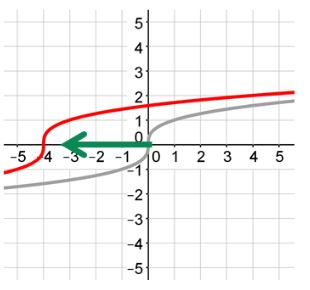
Negative
If h is negative, the graph will be translated right.


The value of k
Positive
If k is positive, the graph will be translated up.

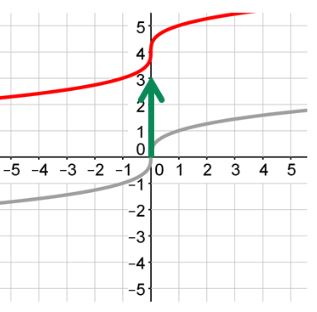
Negative
If k is negative, the graph will be translated down.

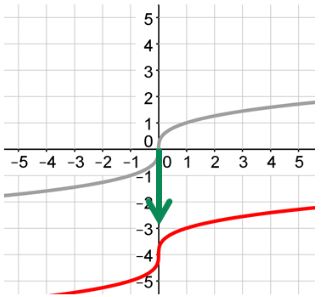
The value of a
Shrunk
If a is between 0 and 1, the graph will be shrunk vertically.

Stretched
If a is larger than 1, the graph will be stretched vertically.
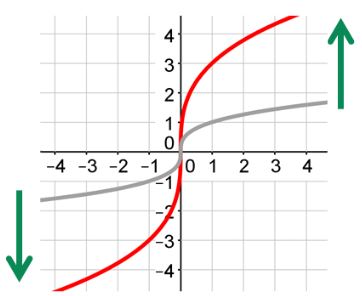
The value of b
Shrunk
If b is larger than 1, the graph will be shrunk horizontally.
This will appear that the graph has been stretched vertically, but the graph is shrinking horizontally.
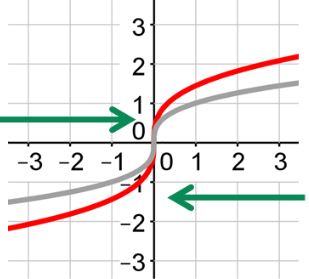
Stretched
If b is between 0 and 1, the graph will be stretched horizontally.
This graph will appear that the graph has been stretched vertically, but the graph is stretching horizontally.
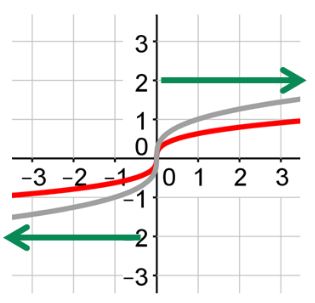
Example #6
Watch Describe the Transformations of a Cube Root Function from Its Parent Graph Given Their Graphs.
Note: The presentation may take a moment to load.
Example #7
Watch Describe the Transformations of a Cube Root Function from Its Parent Graph Given Their Graphs.
Note: The presentation may take a moment to load.
Example #8
Watch Describe the Transformations of a Cube Root Function from Its Parent Graph Given Their Graphs.
Note: The presentation may take a moment to load.
Graphing
Graphing the Cube Root Function
To graph the cube root function, create an x-y table just as you have with other functions. You will want to start with your vertex in the middle of the table. Then, pick two values of x that are greater than the vertex and two values of x that are less than the vertex.
During this section, you will need a scientific calculator. If you do not have a scientific calculator, use this online calculator.
Example #9
Watch Graph a Cube Root Function.
Open Graph a Cube Root Function in a new tab
Note: The presentation may take a moment to load.
Example #10
Watch Graph a Cube Root Function.
Open Graph a Cube Root Function in a new tab
Note: The presentation may take a moment to load.